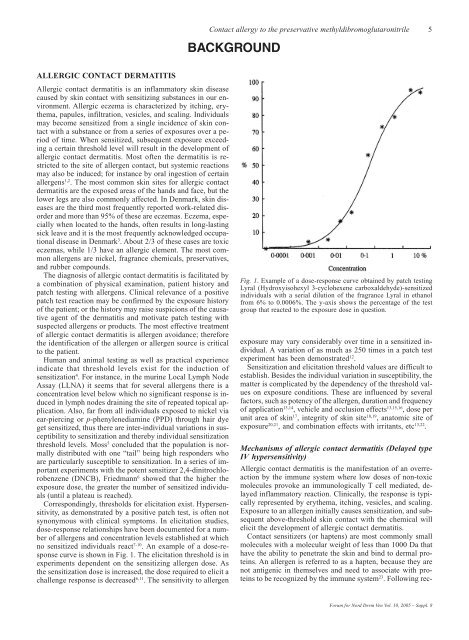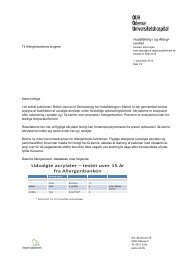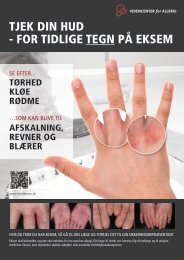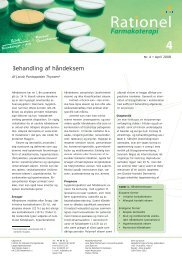Charlotte Devantier Jensen.pmd - Videncenter for Allergi
Charlotte Devantier Jensen.pmd - Videncenter for Allergi
Charlotte Devantier Jensen.pmd - Videncenter for Allergi
Create successful ePaper yourself
Turn your PDF publications into a flip-book with our unique Google optimized e-Paper software.
ALLERGIC CONTACT DERMATITIS<br />
<strong>Allergi</strong>c contact dermatitis is an inflammatory skin disease<br />
caused by skin contact with sensitizing substances in our environment.<br />
<strong>Allergi</strong>c eczema is characterized by itching, erythema,<br />
papules, infiltration, vesicles, and scaling. Individuals<br />
may become sensitized from a single incidence of skin contact<br />
with a substance or from a series of exposures over a period<br />
of time. When sensitized, subsequent exposure exceeding<br />
a certain threshold level will result in the development of<br />
allergic contact dermatitis. Most often the dermatitis is restricted<br />
to the site of allergen contact, but systemic reactions<br />
may also be induced; <strong>for</strong> instance by oral ingestion of certain<br />
allergens 1,2 . The most common skin sites <strong>for</strong> allergic contact<br />
dermatitis are the exposed areas of the hands and face, but the<br />
lower legs are also commonly affected. In Denmark, skin diseases<br />
are the third most frequently reported work-related disorder<br />
and more than 95% of these are eczemas. Eczema, especially<br />
when located to the hands, often results in long-lasting<br />
sick leave and it is the most frequently acknowledged occupational<br />
disease in Denmark 3 . About 2/3 of these cases are toxic<br />
eczemas, while 1/3 have an allergic element. The most common<br />
allergens are nickel, fragrance chemicals, preservatives,<br />
and rubber compounds.<br />
The diagnosis of allergic contact dermatitis is facilitated by<br />
a combination of physical examination, patient history and<br />
patch testing with allergens. Clinical relevance of a positive<br />
patch test reaction may be confirmed by the exposure history<br />
of the patient; or the history may raise suspicions of the causative<br />
agent of the dermatitis and motivate patch testing with<br />
suspected allergens or products. The most effective treatment<br />
of allergic contact dermatitis is allergen avoidance; there<strong>for</strong>e<br />
the identification of the allergen or allergen source is critical<br />
to the patient.<br />
Human and animal testing as well as practical experience<br />
indicate that threshold levels exist <strong>for</strong> the induction of<br />
sensitization 4 . For instance, in the murine Local Lymph Node<br />
Assay (LLNA) it seems that <strong>for</strong> several allergens there is a<br />
concentration level below which no significant response is induced<br />
in lymph nodes draining the site of repeated topical application.<br />
Also, far from all individuals exposed to nickel via<br />
ear-piercing or p-phenylenediamine (PPD) through hair dye<br />
get sensitized, thus there are inter-individual variations in susceptibility<br />
to sensitization and thereby individual sensitization<br />
threshold levels. Moss 5 concluded that the population is normally<br />
distributed with one “tail” being high responders who<br />
are particularly susceptible to sensitization. In a series of important<br />
experiments with the potent sensitizer 2,4-dinitrochlorobenzene<br />
(DNCB), Friedmann 6 showed that the higher the<br />
exposure dose, the greater the number of sensitized individuals<br />
(until a plateau is reached).<br />
Correspondingly, thresholds <strong>for</strong> elicitation exist. Hypersensitivity,<br />
as demonstrated by a positive patch test, is often not<br />
synonymous with clinical symptoms. In elicitation studies,<br />
dose-response relationships have been documented <strong>for</strong> a number<br />
of allergens and concentration levels established at which<br />
no sensitized individuals react 7-10 . An example of a dose-response<br />
curve is shown in Fig. 1. The elicitation threshold is in<br />
experiments dependent on the sensitizing allergen dose. As<br />
the sensitization dose is increased, the dose required to elicit a<br />
challenge response is decreased 6,11 . The sensitivity to allergen<br />
Contact allergy to the preservative methyldibromoglutaronitrile 5<br />
BACKGROUND<br />
Fig. 1. Example of a dose-response curve obtained by patch testing<br />
Lyral (Hydroxyisohexyl 3-cyclohexene carboxaldehyde)-sensitized<br />
individuals with a serial dilution of the fragrance Lyral in ethanol<br />
from 6% to 0.0006%. The y-axis shows the percentage of the test<br />
group that reacted to the exposure dose in question.<br />
exposure may vary considerably over time in a sensitized individual.<br />
A variation of as much as 250 times in a patch test<br />
experiment has been demonstrated 12 .<br />
Sensitization and elicitation threshold values are difficult to<br />
establish. Besides the individual variation in susceptibility, the<br />
matter is complicated by the dependency of the threshold values<br />
on exposure conditions. These are influenced by several<br />
factors, such as potency of the allergen, duration and frequency<br />
of application 13,14 , vehicle and occlusion effects 13,15,16 , dose per<br />
unit area of skin 17 , integrity of skin site 18,19 , anatomic site of<br />
exposure 20,21 , and combination effects with irritants, etc 13,22 .<br />
Mechanisms of allergic contact dermatitis (Delayed type<br />
IV hypersensitivity)<br />
<strong>Allergi</strong>c contact dermatitis is the manifestation of an overreaction<br />
by the immune system where low doses of non-toxic<br />
molecules provoke an immunologically T cell mediated, delayed<br />
inflammatory reaction. Clinically, the response is typically<br />
represented by erythema, itching, vesicles, and scaling.<br />
Exposure to an allergen initially causes sensitization, and subsequent<br />
above-threshold skin contact with the chemical will<br />
elicit the development of allergic contact dermatitis.<br />
Contact sensitizers (or haptens) are most commonly small<br />
molecules with a molecular weight of less than 1000 Da that<br />
have the ability to penetrate the skin and bind to dermal proteins.<br />
An allergen is referred to as a hapten, because they are<br />
not antigenic in themselves and need to associate with proteins<br />
to be recognized by the immune system23 . Following rec-<br />
Forum <strong>for</strong> Nord Derm Ven Vol. 10, 2005 – Suppl. 8

















